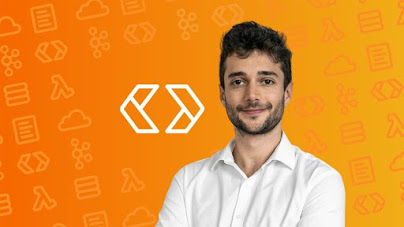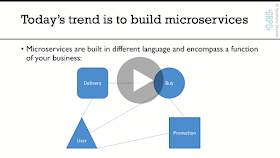If you are a Java developer then you might have heard about the gPRC, the Google Remote Procedure Call solution. It's the latest buzz in the tech circle, and people are talking enthusiastically about it. The buzz is evident because it's coming from Google like Angular, Golang, Flutter, Dart, TensorFlow, and other latest technologies. For those who don't know, gRPC is a super-fast, super-efficient Remote Procedure Call (PRC) system that will help you to develop distributed systems like Microservices. This means you can use gPRC to communicate between your Microservices at super-fast speed. Similar to other RPC solutions like SOAP, it allows a client application to call a method on the server as it is a local object. The server defines service and indicates that it can be called remotely with method parameter and return type and then provides implementation and an RPC server that can handle client calls.
This RPC server takes care of converting your data into bytes (serialization) so that it can travel to the server and then feed the response back to the client. For client code, this is all done by the RPC framework, and it doesn't know or care about it.
The best thing is that clients and servers can be on different technologies. For example, you can build the development server in Java or C++ and write your client application in Python, JavaScript, Ruby, Go, Dart, or any other programming language.
In the case of gRPC, the serialization bit is done using Google Protocol Buffer, also known as proto. Though it's not mandatory and you can also use other data formats like JSON for exchanging data between client and server.
The gRPC protocol is based upon HTTP2 and uses many of its features such as compressing headers, persistent single TCP connections, cancellation, and timeout contracts between client and server. gRPC support two type of client-server communication - unary and Streaming.
Unary is like an asynchronous request that blocks until a response is received. At the same time, Streaming is very powerful and allows both client and server to push messages as well as bi-directional flow where both client and server sending data in two streams in the same method.
Another benefit of gRPC is that the latest version of Google APIs will also have gPRC support so that you can easily create a client using gRPC protocol. If you want to learn more about gRPC and looking for some excellent resources, then you have come to the right place.
5 Best Online Courses to learn gRPC & Google Protocol Buffer in 2025
I have often said that there is no better way to learn a new technology than by joining an online course. It removes your first obstacle with support, and you see things working live, which makes it easier to understand the bigger picture as well as low-level work.It's been a long time since I wrote about Google Protocol Buffer and how it can be used as an alternative to Serialization in Java but finally, the wait is over. In this article, I am going to share some of the best courses to learn gRPC protocol and Google Protocol Buffer for programmers.
These courses will help you to understand both gPRC and Google Protobuf in depth. Anyway, without wasting any more of your time, here is my list of best online courses to learn gRPC and protobuf for programmers and software developers.
1. Complete Guide to Protocol Buffers 3 [Java, Golang, Python]
Before knowing about gPRC, it's essential to know about Google's protocol buffer, and this is one of the best courses by Stephane Maarek to learn google Profotocl Buffer. Having attended Stephane's AWS courses, I was pretty excited to discover that he has also created a course on gPRC, and it turns out to be a gem well.If you don't know, Protocol Buffers (protobuf) is an original data serialization format that every programmer should know about. It is leveraged by many top tech companies such as Google and enables Microservices to transfer data in a form that is safe and efficient.
In this course, you will learn Google Protobuf with examples and exercises. You will also code in Java, Python, and Golang and learn gRPC in-depth, with hands-on lectures, including all the aspects of Protocol Buffers 3.
After finishing this course, you will know everything you need to know to create both simple and complex .proto files, and write code in your favorite Programming language such as Java, Python, and Go. In short, one of the better courses to learn gPRC from an excellent instructor.
2. gRPC [Java] Master Class: Build Modern API & Microservices
Now that you know what Google Protocol buffer is and how you can use it to transmit data between your Microservices, it's time to learn how to develop server-side code using gPRC.This is one of the best courses to learn gRPC for Java developers. It will teach you how to build a fast and scalable HTTP2 API for your microservice architecture with gRPC and Google Protocol Buffers (protobuf)
In this article, you will first learn about gRPC and how exactly gRPC works. After that, you will learn how to write your service definition using .proto files and how to implement unary, server streaming, client streaming, and bi-directional streaming API.
You will also learn the difference between the gRPC and REST API paradigms and understand the benefits offered by the gRPC framework. You will also learn how to implement advanced concepts such as Error handling and SSL Security.
Overall, an in-depth course to learn gPRC for Java developers to build Modern APIs and lighting fast Microservices.
3. Enhancing Application Communication with gRPC
There have been many different strategies over the years to get software written in one language to communicate with one written in another. The two primary approaches that have evolved have been RESTful services (typically using JSON documents to transmit data) and RPC (remote procedure calls) that use a variety of different transmission techniques.In this course, you will learn about the gRPC framework that Google uses for much of its inter-service communication. First, you'll cover the components of the gRPC application.
Next, you'll discover how to use protocol buffers to define gRPC services.
Finally, you'll learn how to create gRPC clients and servers using C#, Java, Node.js, and Go. By the end of this course, you'll know how to use gRPC in your distributed system applications.
4. gRPC [Golang] Master Class: Build Modern API and Microservices
Better than REST API! Build a fast, scalable HTTP/2 API for a Golang microservice with gRPC, Protocol Buffers (protobuf)gRPC is a new and modern framework for building scalable, stylish, and fast API. It is leveraged by many top tech companies such as Google, Square, and Netflix. It enables programmers to write micro-services in any language they want while keeping the ability to easily create communications between these services. It relies on Google Protocol Buffers for the transport mechanism and Service Definition language.
In this course, we are going to explore in-depth, with hands-on lectures, all the aspects to get started with gRPC. This course is hands-on, and you will implement two services: Greet and a Calculator Service.
In just a few hours, you will know everything you need to know to write your .proto files, generate code in your favorite Programming, and implement your services, servers, and client in Golang. There will be plenty of hands-on lectures and exercises for you to practice your newly acquired skills.
5. gRPC C# Master Class: Build Modern API & Microservices
If you are a C# developer and want to learn gRPC, then this is an excellent cours for you. In this course, you will learn how to create a fast, scalable HTTP/2 API for a .NET microservice with gRPC, Protocol Buffers (protobuf)This is another hands-on course by Stephane Marak, where you will learn all the aspects to get started with gRPC from a C# developer perspective. As part of the course, you will develop two services: Greet and a Calculator Service.
After completing this course, you will know how to write your .proto files, generate code in your favorite programming language, and implement your services, servers, and client in .NET.
In short, the best online course to learn gPRC for C# and .NET developers.
That's all about the best courses to learn gRPC and Google Protocol Buffer in Java, C#, and Golang. As you can see, gPRC is from Google and promise to provide high-performance communication between microservices, which makes it really suitable for cloud and distributed application development.
If you are looking to learn a new technology this year, I suggest you explore gRPC and Google Protocol buffer in your favorite programming languages like Java, Python, Golang, or C#.
Thanks for reading this article so far. If you find these courses useful in learning gRPC and Google Protocol Buffer in 2025, then please share them with your friends and colleagues. If you have any questions or feedback, then please drop a note.
P. S. - If you are new to the Java and Microservices world and looking for some online courses to start learning Java and Microservices with a more established framework like Spring Boot hen you can also check out this list of Java Microservices with Spring Boot courses to start your journey.
Other Programming Resource articles you may like to explore
- Top 7 Courses to learn Microservices in Java
- 10 Advanced Core Java Courses for Experienced Programmers
- 5 Free Spring Framework Courses for Java Developers
- 5 Courses to Learn Web Development in 2025
- Top 5 Courses to learn Regular Expression
- Top 5 Java design patterns courses for experienced Java devs
- 10 courses for Programming/Coding Job Interviews
- Top 5 Courses to learn Spring in Depth
- 10 Advanced Spring Boot Courses for Java developers
- Top 5 Courses to learn Spring Cloud for Beginners
- 5 Online Courses to learn Core Java for Free
- 5 Courses to learn Shell Scripting in Linux
- 10 Free Spring Boot Tutorials and Courses for Java Devs
Thanks for reading this article so far. If you find these courses useful in learning gRPC and Google Protocol Buffer in 2025, then please share them with your friends and colleagues. If you have any questions or feedback, then please drop a note.
P. S. - If you are new to the Java and Microservices world and looking for some online courses to start learning Java and Microservices with a more established framework like Spring Boot hen you can also check out this list of Java Microservices with Spring Boot courses to start your journey.





No comments:
Post a Comment